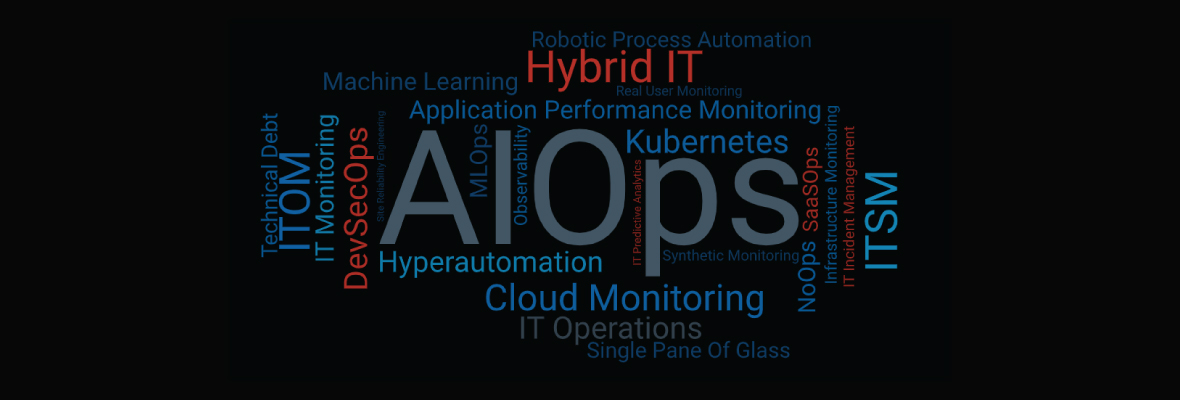With increasing complexity and workloads, the world of IT operations is constantly evolving to meet the needs of digital-first organizations. Automation, AI and DevOps are intersecting today like never before. A constant influx of new technologies means new terms. Here's our take on the meaning of leading words and phrases in the space right now:
- AIOps
AIOps stands for Artificial Intelligence for IT Operations. AIOps leverages a broad set of technologies, including machine learning, network science, combinatorial optimization, and other computational approaches for solving everyday IT operational problems at scale. In simple terms, AIOps collects data from various sources and analyzes that data to give actionable insights to organizations. - Application Performance Monitoring (APM)
APM tools monitor the performance and availability of software applications and the IT services they rely on, such as databases and application and web servers. APM tools typically can trace performance issues across the application stack and also have code-level visibility to detect problems in the application code, such as a database or service call. - Cloud Monitoring
Cloud monitoring is the process of reviewing, monitoring and managing the operational workflow and processes within a cloud-based IT asset or infrastructure. In a multi-cloud and hybrid IT world, you need a cloud monitoring service that can integrate all your data and tools for unified intelligence. - DevSecOps
DevSecOps combines DevOps with SecOps, creating a cyclical practice for software development, technology operations and cyber security. It is done to promote the fast development of a secure code base. - Hybrid IT
Hybrid IT refers to the use of both in-house and cloud-based services to host and deliver IT assets. A hybrid IT model enables organizations to lease a portion of their required IT resources from a public/private cloud service provider. - Hyperautomation
Hyperautomation refers to the use of advanced technologies, like artificial intelligence (AI), machine learning (ML), and robotic process automation (RPA), to automate tasks that were once done manually. Hyperautomation not only refers to the tasks and processes that can be automated, but also the level of automation. It is often referred to as the next major phase of digital transformation. - Infrastructure Monitoring
IT infrastructure monitoring is the deployment of a built-in knowledge base to automatically diagnose performance and availability problems across the technology stack. According to Gartner, “ITIM tools monitor and collate the availability and resource utilization metrics of servers, networks, database instances, hypervisors and storage. Notably, these tools collect metrics in real time and perform historical data analysis or trending of the elements they monitor.” - IT Incident Management
In a modern enterprise with shadow IT and global teams, alert fatigue is bound to happen. IT incident management is a practice wherein the IT team returns a service to normal as quickly as possible after a service disruption, with as little negative impact on the business as possible. Incident management also covers how incidents are detected and communicated, who is responsible, the tools used, and the steps taken to resolve an incident. - IT Monitoring
IT monitoring is the process of collecting and analyzing metrics about the operations of an IT environment to ensure the technology components function as expected to support applications and services. - ITOM
IT operations management (ITOM) software is intended to represent all the tools needed to manage the provisioning, capacity, performance and availability of computing, networking and application resources — as well as the overall quality, efficiency and experience of their delivery. - IT Operations
Gartner defines IT operations as the people and management processes associated with IT service management to deliver the right set of services at the right quality and at competitive costs for customers. - ITSM
Information Technology Service Management (ITSM) activities are performed by an organization to design, plan, deliver, operate and control information technology (IT) services offered to customers. Differing from more technology-oriented IT management approaches like network management and IT systems management, IT service management is characterized by adopting a process approach towards management, focusing on customer needs and IT services for customers. - Kubernetes
Kubernetes is a portable, extensible, open-source platform for managing containerized workloads and services, that facilitates both declarative configuration and automation. It has a large, rapidly growing ecosystem. The name Kubernetes originates from Greek, meaning helmsman or pilot. - Machine Learning
Machine learning is the use and development of computer systems that can learn and adapt without following explicit instructions, by using algorithms and statistical models to analyse and draw inferences from patterns in data. In IT operations, machine learning tools are used to detect anomalies from the norm in IT operations data, which could indicate a performance issue, a security threat or other problem that could impact IT service levels. - MLOps
MLOps (a compound of “machine learning” and “operations”) is a practice for collaboration and communication between data scientists and operations professionals to help manage the production ML (or deep learning) lifecycle. - NoOps
NoOps (no operations) is the concept that an IT environment can become so automated and abstracted from the underlying infrastructure that there is no need for a dedicated team to manage software in-house. - Observability
Observability differs from monitoring, in that it focuses on the development of the application and rich instrumentation so that operators can ask arbitrary questions about how the software works. - IT Predictive Analytics
Predictive analytics is the use of data, statistical algorithms and machine learning techniques to identify the likelihood of future outcomes based on historical data. The goal is to go beyond knowing what has happened to providing a best assessment of what will happen in the future. In IT Ops, predictive analytics can identify issues before they escalate and help optimize infrastructure for cost savings and user experience. - Real User Monitoring (RUM)
RUM is a passive application monitoring technique that records all user interaction with a website or application, typically through the injection of Javascript code in the website or application being monitored. RUM can be used to monitor user interactions with a website or application, which can then be used to create scripts for synthetic monitoring tools to follow. It can also be used to detect specific performance or navigation issues that cause users to drop off without completing a transaction. - Robotic Process Automation (RPA)
In IT operations, RPA is the practice of using software tools to automate routine or repetitive IT operations tasks with little or no human intervention. Examples of these tasks include patch management, incident management, software installations and upgrades, user experience monitoring, and network monitoring. - SaaSOps
SaaSOps is a practice referring to how software-as-a-service (SaaS) applications are discovered, managed, and secured through centralized and automated operations (Ops), resulting in reduced friction, improved collaboration, and better employee experience. - Synthetic Monitoring
Synthetic monitoring is a monitoring technique that is done by using an emulation or scripted recordings of transactions. It helps track performance metrics such as page load times and end-to-end latency that can affect business outcomes such as user sign-up rates and transaction completion rates. - Single Pane Of Glass
Single pane of glass is a term both loved and cursed by IT pros because it's a hard-to-achieve nirvana. SPOG is achieved through a management tool or integration platform that unifies data and interfaces across different operational tools and presents the data in a single view for decision-making. - Site Reliability Engineering (SRE)
SRE is a concept originated at Google that bridges software development and IT operations by applying a software engineering mindset to system administration. This includes developing more reliable, high-performing systems as well as automation tools that can handle IT ops processes such as monitoring, change management, emergency response and capacity management. - Technical Debt
Technical debt is a concept in software and IT that reflects the implied cost of additional rework caused by choosing an easy (limited) solution now instead of using a better approach that would take longer. In enterprise IT, technical debt may refer to a large tangle of issues including legacy hardware and software, inefficient maintenance processes, lack of scalability or resiliency, poor user experiences, outdated communications or code that's inadequately maintained.






